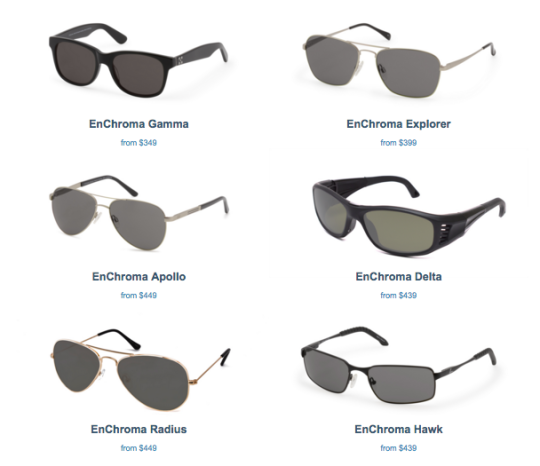Review: These Glasses for Colorblindness Really Work
Hello. My name is David, and I’m colorblind.
That’s right: I’m among the 8 percent of all males (one in 12) who see less red and green pigment than everyone else. (Technically speaking, red and green “sensors” in our eyes overlap, making those colors tough to distinguish.)
Here are some of the well-meaning but misguided questions colorblind people get asked a lot:
“So does everything look like a black-and-white TV to you?” (Answer: “Colorblind” doesn’t mean you see everything in black and white; in most cases, it just means that you see less red and green. So it’s hard to tell blue apart from purple, or to tell green apart from brown, or to detect any color at all in very light shades.)
“What color is the sky?” (Answer: Blue.)
“How do you know when to go at a traffic light?” (Answer: To me, the “green” light of a traffic light looks perfectly white — but it’s still on the bottom, so, yes, I know when to go.)
If it’s any help, here’s what fall foliage looks like to a colorblind person:

And here’s what it looks like to everyone else:

To me, the pictures look exactly the same.
EnChroma sunglasses
A few years ago, I discovered that a company called EnChroma had developed sunglasses for colorblind people that it claimed would make those missing colors visible. I couldn’t wait to see if they could work for me.

So I tried them out. This is what I wrote at the time:
I was surprised to read some of the disclaimers. First, they’re sunglasses. They don’t work indoors unless the light is very bright. Second, they’re not designed for use with a computer screen.
And, weirdly enough, these glasses won’t help you pass the standard Ishihara colorblindness test, the one in which you try to see a number composed of hundreds of dots in a circular test pattern.
In any case, I took them outside on a sunny day — and was floored. I mean, I had a visceral reaction to what I saw.
Colors I see just fine — blues, yellows, oranges — looked exactly the same. But all of a sudden, greens and reds looked richer. It’s almost impossible to describe in words. In fact, it’s impossible for normal-vision people to understand, even by wearing them, because they don’t see anything different with the EnChroma glasses on.
But an old brown Vermont barn roof was revealed, quite clearly, to be salmon red. Yards full of leafy trees and plants suddenly had different shades of green. Everywhere I looked, desaturated or barely discernible red things were popping.
The highlight came on day four of my tests, when my kids discovered a rainbow arcing across the sky, pointing and exclaiming. I looked. With my own eyes, I could barely see it. Maybe there was a soft arc of yellow, but that was it.
Then I put on the glasses. Unbelievable! Now I saw two entire additional color bands, above and below the yellow arc. It was suddenly a complete rainbow. I don’t mind admitting, I felt a surge of emotion. It was like a peek into a world I knew existed but had never been allowed to see.
EnChroma updates
Well, that was almost three years ago. Since that time, a lot has happened.
First, the public began to discover EnChroma glasses. We began to see videos like this one, showing colorblind people falling apart emotionally when they see full color for the first time.
Second, EnChroma has branched out, expanding its styles and offerings. Now there are 20 different frame types, plus interchangeable-lens models and even custom lenses to fit your existing frames.
There’s also now a lens specifically for use indoors — when looking at a computer screen, for example. The lenses use the same technology, just a lot less of it; they’re barely tinted.

In general, they didn’t do much for me. I was, however, astonished to discover that they let me pass many more of the Ishihara tests. I can clearly see the number in this pattern, for example:

(Without the glasses, I see just a mass of shaded dots.)
On the other hand, with the glasses on, I can no longer see the number hiding in other dot patterns! So it’s a win-some, lose-some situation.
The third thing that’s happened is that the price of EnChroma glasses has dropped. Now you can get a pair for $350. They’re not the cheapest sunglasses you can buy, of course, but they’re now within shouting distance of regular high-end sunglasses.
Do they work?
Now, assessing EnChroma glasses isn’t like assessing a laptop or a phone. There’s no way to draw an absolute conclusion. Everybody’s eyes are different, including those who are colorblind.
EnChroma says that its glasses can help about 80 percent of colorblind people; according to the test on the EnChroma website, I’m among the least likely to be helped. (I’m a “strong Protan,” in colorblind lingo.)
Even so, the latest models still gave me a punch in the gut. These leaves all looked the same to me without the sunglasses. When I put on the glasses, the bushes popped into two different hues: red and green.

And when I went driving through Connecticut wearing them during fall-foliage season — whoa, baby! The reds of the leaves were so brilliant that I had a hard time keeping my eyes on the road.
Buy them?
At the end of my original review, I wrote that I decided not to buy the sunglasses. As a disability, colorblindness isn’t anywhere near the same league as, say, deafness or regular blindness. Truth is, unless you’re an interior designer or something, colorblindness doesn’t really affect you that much. You have nothing to compare it with, so you’re generally unaware of what you’re missing.
But, wow, you can’t believe how opinionated and hostile my readers were. They thought I was insane. “What is WRONG with you? Why wouldn’t you pay $600 to bring back the glory of a rainbow?” went a typical refrain.
I was a little shocked. How is it their business to judge how important color vision is to a colorblind person?
That reaction reminded me of people’s automatic assumption that every deaf person wants cochlear implants to restore some hearing. Similarly, plenty of blind people consider their vision impairment a difference, not a drawback.
Anyway. EnChroma glasses exist. For 80 percent of us, they really work — they restore the missing reds and greens to our vision — and for some people, the results are emotionally overwhelming. (The sunglasses come with a 30-day money-back guarantee, so you have nothing to lose by trying them.) The price is more sane now, there’s an indoor edition, and the technology has gotten even better.
So, yes, dear readers: This time, I’m sold. I’m buying a pair for myself.
But don’t worry. The next time the leaves change, I’ll let someone else do the driving.
David Pogue is the founder of Yahoo Tech; here’s how to get his columns by email. On the Web, he’s davidpogue.com. On Twitter, he’s @pogue. On email, he’s poguester@yahoo.com. He welcomes nontoxic comments below.

